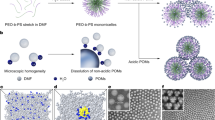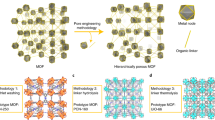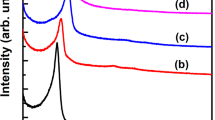Abstract
Mesoporous bulk1,2,3,4 and thin-film5,6,7 silicates with pore sizes of 20–100 Å can be synthesized by using micellar aggregates of long-chain organic surfactant molecules as templates to direct the structure of the silicate network. Because of the potential applications of these molecular-sieve materials as catalysts, separation membranes and components of sensors, it is desirable to extend the range of accessible pore sizes and material compositions. Mesoporous oxides in which transition metals partially8 and fully9,10,11,12,13 substitute for silicon have been made by similar means, in the latter case by ensuring strong interactions between the surfactants and the transition-metal alkoxide precursors. Templating with organic molecules has also been long used for the synthesis of microporous materials—synthetic zeolites—which have smaller pore sizes (4–15 Å), but here the organic molecules are shorter-chain amphiphiles which are too small to be considered true surfactants and so act as discrete entities around which the framework crystallizes14,15,16. Here we show that even such short-chain molecules can aggregate into supramolecular templates when they form bonds with transition-metal (niobium) alkoxides, and that in this way they can direct the formation of transition-metal oxides with pore sizes of less than 20 Å. These pore sizes, which result from the smaller diameter of micellar structures of the short-chain amines relative to the longer-chain surfactants used for the synthesis of mesoporous materials, qualify the resulting molecular sieves as microporous, even though the supramolecular templating mechanism is similar to that used to make the mesoporous materials. Thus our approach extends the supramolecular templating method to afford microporous transition-metal oxides.
This is a preview of subscription content, access via your institution
Access options
Subscribe to this journal
Receive 51 print issues and online access
$199.00 per year
only $3.90 per issue
Buy this article
- Purchase on Springer Link
- Instant access to full article PDF
Prices may be subject to local taxes which are calculated during checkout





Similar content being viewed by others
References
Kresge, C. T., Leonowicz, M. E., Roth, W. J., Vartuli, J. C. & Beck, J. S. Ordered mesoporous molecular sieves synthesized by a liquid-crystal template mechanism. Nature 359, 710–712 (1992).
Beck, J. S. et al. Anew family of mesoporous molecular sieves prepared with liquid crystal templates. J. Am. Chem. Soc. 114, 10834–10843 (1992).
Beck, J. S. et al. Molecular or supramolecular templating: defining the role of surfactant chemistry in the formation of microporous and mesoporous molecular sieves. Chem. Mater. 6, 1816–1821 (1994).
Davis, M. E. Organizing for better synthesis. Nature 364, 391–393 (1993).
Yang, H., Kuperman, A., Coombs, N., Mamiche-Afara, S. & Ozin, G. A. Synthesis of oriented films of mesoporous silica on mica. Nature 379, 703–705 (1996).
Yang, H., Coombs, N., Solokov, I. & Ozin, G. A. Free-standing and oriented mesoporous silica films grown at the air–water interface. Nature 381, 589–592 (1996).
Aksay, I. A. et al. Biomimetic pathways for assembling inorganic thin films. Science 273, 892–898 (1996).
Tanev, P. T., Chibwe, M. & Pinnavaia, T. J. Titanium-containing mesoporous molecular sieves for catalytic oxidation of aromatic compounds. Nature 368, 321–323 (1994).
Antonelli, D. M. & Ying, J. Y. Synthesis of stable hexagonally-packed mesoporous niobium oxide molecular sieves through a novel ligand-assisted templating mechanism. Angew. Chem. Int. Edn Engl. 35, 426–430 (1996).
Antonelli, D. M., Nakahira, A. & Ying, J. Y. Ligand-assisted liquid crystal templating in mesoporous niobium oxide molecular sieves. Inorg. Chem. 35, 3126–3136 (1996).
Antonelli, D. M. & Ying, J. Y. Synthesis of hexagonally-packed mesoporous TiO2by a modified sol-gel method. Angew. Chem. Int. Edn Engl. 34, 2014–2017 (1995).
Antonelli, D. M. & Ying, J. Y. Synthesis and characterization of hexagonally-packed mesoporous tantalum oxide molecular sieves. Chem. Mater. 8, 874–881 (1996).
Antonelli, D. M. & Ying, J. Y. Mesoporous materials. Curr. Opin. Coll. Interface Sci. 1, 523–529 (1996).
Flanigen, E. M., Patton, R. L. & Wilson, S. T. Structure, synthetic and physiocochemical concepts in aluminophosphate-based molecular sieves. Stud. Surf. Sci. Catal. 37, 13–27 (1988).
Chen, C.-Y., Burkette, S. L., Li, H.-X. & Davis, M. E. Studies on mesoporous materials. II. Synthesis mechanism of MCM-41. Microporous Mater. 2, 27–34 (1993).
Davis, M. E. & Lobo, R. F. Zeolite and molecular sieve synthesis. Chem. Mater. 4, 756–768 (1992).
Huo, Q. et al. Generalized synthesis of periodic surfactant/inorganic composite materials. Nature 368, 317–321 (1994).
Monnier, A. et al. Cooperative formation of inorganic-organic interfaces in the synthesis of silicate mesostructures. Science 261, 1299–1303 (1993).
Acknowledgements
We thank D. M. Antonelli for discussions, and Z. Zhang and M. Frongillo for assistance with TEM. This work was supported by the Packard Foundation and the NSF.
Author information
Authors and Affiliations
Corresponding author
Rights and permissions
About this article
Cite this article
Sun, T., Ying, J. Synthesis of microporous transition-metal-oxide molecular sieves by a supramolecular templating mechanism. Nature 389, 704–706 (1997). https://doi.org/10.1038/39549
Received:
Accepted:
Issue Date:
DOI: https://doi.org/10.1038/39549
This article is cited by
-
Editing porcine IGF2 regulatory element improved meat production in Chinese Bama pigs
Cellular and Molecular Life Sciences (2018)
-
Oxidation-extraction desulfurization of model oil over Zr-ZSM-5/SBA-15 and kinetic study
Frontiers of Chemical Science and Engineering (2014)
-
Cells made of silica
Nature Nanotechnology (2012)
-
Nonionic polymeric surfactant template for mesoporous NiCo2O4 formation
Journal of Porous Materials (2011)
-
Preparation of Thin Porous Silica Foam on Alumina Disk Substrate
Catalysis Letters (2006)
Comments
By submitting a comment you agree to abide by our Terms and Community Guidelines. If you find something abusive or that does not comply with our terms or guidelines please flag it as inappropriate.



